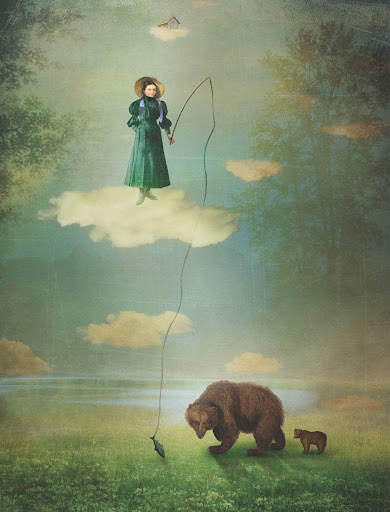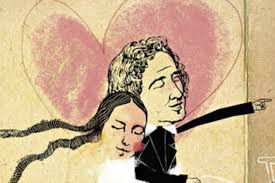Ever since I was a teenager, I have been fascinated by novels which imagine the lives of real-life artists.
My interest was sparked by The Agony and The Ecstasy, which I read when I was fourteen. It retells the life of Michelangelo Buonarroti by the American writer Irving Stone. Published in 1961, it opens with a quote from Michelangelo: ‘If I was made for art, from childhood ... a prey for burning beauty to devour, I blame the mistress I was born to serve.’
An extraordinarily vivid and confident novel, The Agony and The Ecstasy took Stone six years to research. He lived in Italy during this time, worked as an apprentice for a marble sculptor, and arranged to have all four hundred and ninety-five of Michelangelo’s letters translated (they have since been published I, Michelangelo, Sculptor by the translator, Charles Peroni.) Part of the novel was made into a film (1965) starring Charlton Heston as Michelangelo.
Since then, I have read many other biographical novels about artists (the term was coined by Irving Stone). Here are a few of my favourites:
The Miracles of Prato by Laurie Albanese and Laura Morowitz is the story of the scandalous love affair between Fra Filippo Lippo, a monk and artist, and his model and muse, Lucrezia. Her face appeared in many of his paintings (and she truly was beautiful). In some accounts, he abducted her from the convent in which she was a novitiate - they then lived together in defiance of the Church in 15th century Italy, having two children together, one of which was the artist Filippino Lippo. Their love affair is a fascinating story, and resulted in some gorgeous early Renaissance paintings.
Leonardo's Swans by Karen Essex is a novel about a woman who longs to be painted by Leonardo da Vinci. Set at the Renaissance court of Ludovico Sforza, Duke of Milan, it tells the story of two real life sisters, Beatrice – who marries the duke of Milan - and Isabella, who becomes one of the most important art collectors of her day. The two sisters become rivals in love, and the coveted sitting for Leonardo da Vinci becomes a symbol of power and prestige, as well as a bid for immorality. Meticulously researched, this novel illuminated the milieu in which da Vinci worked and brings to life two passionate and thwarted women.
I, Mona Lisa by Jeanne Kalogridis imagines the life of the woman with the most famous smile in art history. The story of Lisa di Antonio Gherardini, the name of the woman believed to be the sitter for Leonardo da Vinci's most famous portrait, this is a vibrant, romantic and action-packed read that vividly depicts life in Florence under the rule of the mad monk, Savonarola.
Sarah Dunant’s The Birth of Venus is also set in Florence during the days of Savonarola. The novel’s heroine, Alessandra, longs to be a painter and falls passionately in love with a mysterious artist commissioned to paint the family chapel. Famous artists such as Botticelli, Michelangelo, Fra Angelico and Leonardo da Vinci wander through the narrative, but it is the thwarted desires and ambitions of Alessandra which power this astonishing novel, and which give the brilliant surprise twist at the end.
One woman artist who succeeded in making her way in the autocratic and male-dominated world of the Italian Renaissance was Artemisia Gentileschi, the first woman to be elected to the Accademia dell'Arte in Florence. Until I read Susan Vreeland’s novel The Passion of Artemisia, I knew very little about her or her life. Born in 1593, Artemisia Gentileschi was the daughter of the well-known artist, Orazio Gentileschi. The novel begins in 1612, when a young Artemisia is put on trial in Rome after being raped by her teacher, Agostino Tassi. She is actually tortured by the court to establish whether she was lying or not, while her attacker is not punished at all. This ordeal is thereafter reflected in her art, usually dark and dramatic depictions of women in history. One of her favourite subjects was the Biblical story of Judith, who chopped off the head of Holofernes. For the rest of her life, Artemisia struggled to make her way as a woman and an artist, and this is a truly brilliant depiction of that struggle.
Portrait of an Unknown Woman by Vanora Bennett tells the story of one of Sir Thomas More’s foster daughters, who finds herself torn between the German artist Hans Holbein and her tutor. The novel is centered around two portraits Holbein painted of More’s family, painted almost five years apart. In the interim, Holbein’s talent and insight deepened significantly, and the book contains the two paintings as end-pages so you can examine them in detail. It is also a fascinating look at the life of Sir Thomas More in the dangerous days of Henry VIII and Anne Boleyn.
The world of the Dutch painter Rembrandt Harmenszoon van Rijn is vividly recreated in Rembrandt's Whore, by Sylvie Matton. Published in 2003, the book is told from the point of view of Hendrickje Scoffels, Rembrandt's mistress, who comes to his household as a young woman to model for him, becomes his lover and mistress, and stays to care for him as he ages.
One of my favourite books of all time is Tracy Chevalier's Girl With a Pearl Earring, which many critics credit with kick-starting the current fashion for novels about artists. Published in 1999, it tells the story of Griet, a young girl whose family misfortune sees her go to work as a maid for Dutch artist Jan Vermeer. The world of 17th century Holland is so real you can smell it, and Vermeer and his art are beautifully illuminated.
Coincidentally, Susan Vreeland's novel about a Jan Vermeer painting Girl in Hyacinth Blue was published in the same year and it too is one of my favourite novels about art, though its focus is on the history of a single Vermeer painting. It is really an extraordinary book, being composed as a series of short vignettes that show the effect one painting can have on different people throughout the centuries.
Susan Vreeland has also written The Forest Lover, about the Canadian artist Emily Carr and Life Studies, a series of short stories about the lives and loves of Claude Augustus Renoir, Claude Monet, Edouard Manet, Vincent Van Gogh, Paul Cezanne and Modigliani.
Her novel , Luncheon of the Boating Party, describes how the thirty-nine year old Renoir came to create the famous painting of the same name. Happily, the novel’s cover shows a replica of the painting as I was constantly turning the pages to stare at the cover and identify each character. Taking place over the course of a month of Sundays, this book illuminated so much about Renoir and his life and philosophy, as well as life in 1880s France.
Light by Eva Figes, published in 1983, is an impressionistic portrait of one day in the life of Claude Monet. It begins with sunrise on a day in 1900, and moves slowly through the hours towards sunset, expressing the thoughts of the artist and those around him, whose lives are as much in thrall to his craft as Monet himself.
Alyson Richman's 2006 novel The Last Van Gogh imagines a tender and ultimately tragic love story between the artist Vincent van Gogh and Marguerite Gachet, the twenty- year-old daughter of the country doctor who treats him during the last months of his life. Van Gogh spent seventy days at Auvers-sur-Oise during which time he painted an incredible seventy paintings, several of them of Margeurite. They were among the last paintings he created before he shot himself.
Irving Stone, who began my love of books about artists, also wrote a novel based on the life of Vincent Van Gogh, entitled Lust for Life. His primary source was Van Gogh's letters to his brother Theo. It was Stone’s first book, published in 1934, and was adapted into a film starring Kirk Douglas, which was nominated for four Academy Awards. The book is most famous for the way it describes the origins of many of van Gogh’s famous paintings like ‘The Potato Eaters’ and ‘Sunflowers’.
The passionate lives and loves of the Pre-Raphaelites are the subject of Elisabeth Hickey’s novel, The Wayward Muse. Jane Burden was living in squalor and poverty when Dante Gabriel Rossetti came up to her in a theatre and said, ‘I apologise for my boldness but I must tell you that you’re the most beautiful girl in Oxford ... I have to put you in my painting.’ So began a passionate relationship that survived despite Jane’s marriage to Rossetti’s friend William Morris, the tragic suicide of Rossetti’s wife Lizzie Siddal, and Rossetti’s ultimate madness. Elizabeth Hickey has also written The Painted Kiss, about the possible love affair between Gustav Klimt and one of his models, Emilie Floge, in fin-de-siecle Vienna, ‘the most beautiful, cosmopolitan city in the world’.
Finally, The Lacuna by Barbara Kingsolver, which recently won the £30,000 Orange Prize for Fiction in the UK. It tells the story of a sensitive young American who works in the tumultuous household of Diego Rivera and Frida Kahlo, while they shelter Leon Trotsky. Frida in particular is brought to vivid and memorable life and, like all good novels that feature the lives of artists, took me back to her pore over her paintings, finding them illuminated by my new understanding of her as a woman and as an artist. As Rivera said of his wife, ‘Never before had a woman put such agonizing poetry on canvas as Frida did.’
Kate Forsyth is the internationally bestselling author of numerous books for both adults and children. She is currently researching a book in which Tiziano Vecelli (better known as Titian) and his mysterious red-haired muse will appear.
Books About Artists for Children
Camille and the Sunflowers by Laurence Anholt
Degas and the Little Dancer by Laurence Anholt
Leonardo and the Flying Boy by Laurence Anholt
Frida Kahlo: The Artist who Painted Herself by Margaret Frith
Suzette and the Puppy: A Story About Mary Cassatt by Joan Sweeney
Picasso and the Girl with a Ponytail by Laurence Anholt
Katie And The Mona Lisa by James Mayhew
Katie Meets The Impressionists by James Mayhew
Katie And The Sunflowers by James Mayhew
A Bird or 2: A Story About Henri Matisse by Bijou Le Tord
My Name Is Georgia by Jeanette Winter
Bijou, Bonbon and Beau: The Kittens Who Danced for Degas by Joan Sweeney







